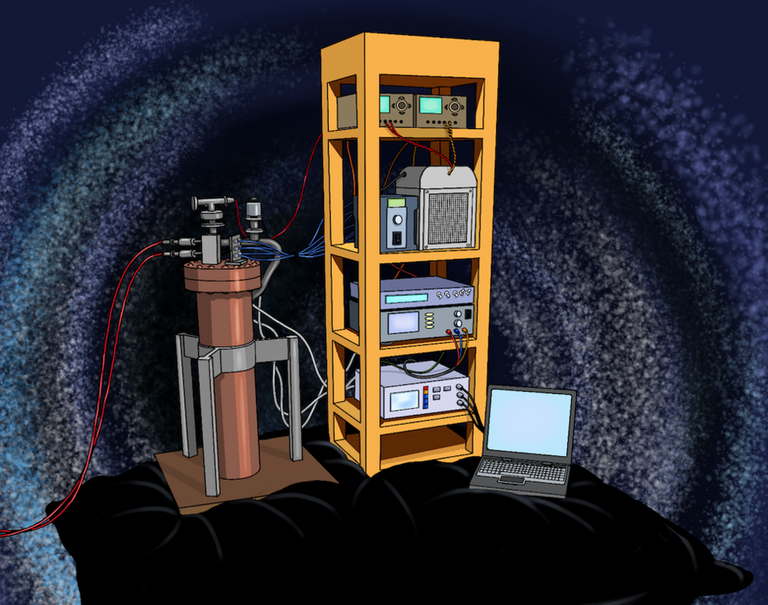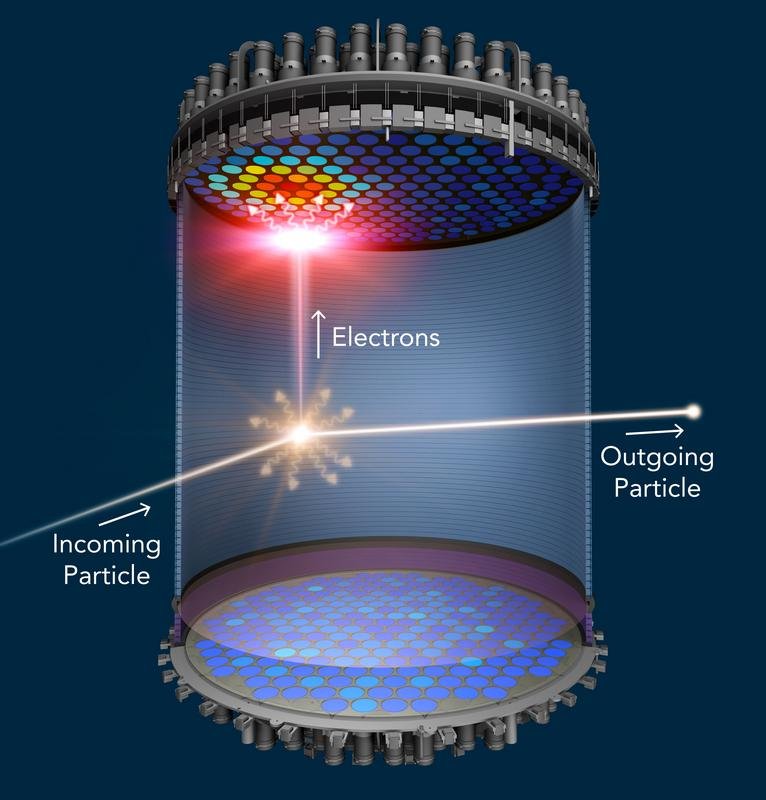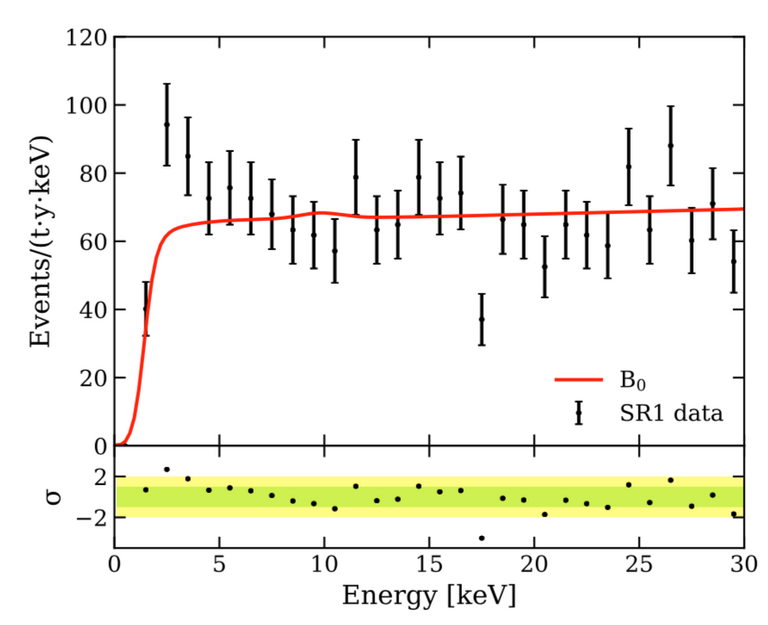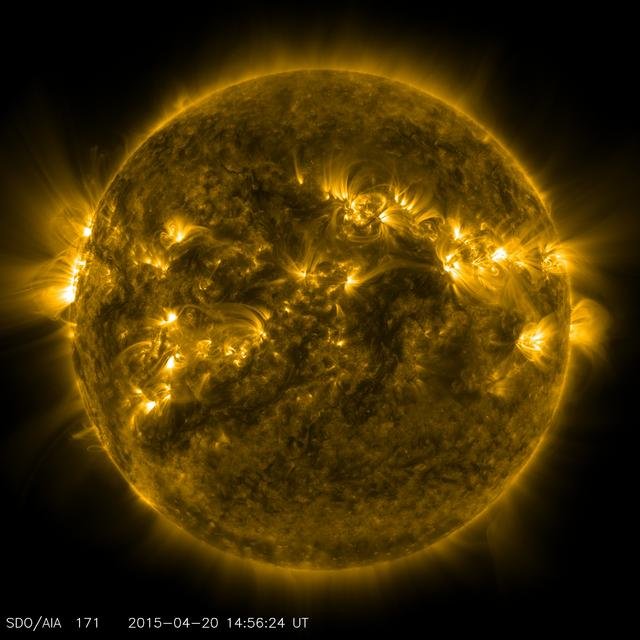Last Wednesday the XENON1T dark matter experiment, located in Gran Sasso in Italy, released new results that shook the high-energy physics community quite a bit: An unexplained signal was seen in data. I feel that I should share the excitement about this with this blog. But let's proceed step by step.
In the rest of this post, I start by briefly explaining how the XENON1T experiment works and how it has been designed to probe dark matter. I then detail the results of last Wednesday, and emphasise the difference between a hint for a new phenomenon (which is what we have here) and a discovery.
Finally, I provide a few potential explanations for the observation. This will by far not be an extensive review, as new scientific articles appear on a daily basis.

[Credits: @pab.ink]
The XENON1T experiment in a nutshell
Dark matter is indirectly evidenced by a large set of observations. As a consequence, there is a huge experimental effort aiming at its direct detection on Earth. This relies on two principles.

First, dark matter is generally very weakly interacting with normal matter. Interactions between dark and visible matter are therefore rare, but happen.
Next, there is a dark matter wind blowing on the planet so that dark matter particles could go through any detector located on Earth.
However, recording such an event requires dark matter not only to go through the detector but also to interact inside it. Due to the rarity of the dark matter interactions, this happens only occasionally. Nevertheless, with a large detector and some patience, we may see it.
Let's apply this to the XENON1T detector, that is made of a huge quantity of liquid Xenon surrounded by numerous sensors.
When a dark matter particle hits one of the Xenon nuclei making the detector, this nucleus recoils. By recording and analysing such a recoil, we can then conclude about what happened (dark matter or background).
This however requires dark matter to be energetic enough to trigger the nuclear recoil. This is why for light dark matter, one focuses instead on the recoil of the electrons making the detector. Electronic recoils indeed require less energy.
Measuring electronic recoils with XENON1T
The results announced last Wednesday concern those electronic recoils and the appearance of an excess in data. This is illustrated by the figure below, which includes all data taken by XENON1T in the 2016-2018 period.

[Credits: arxiv]
The figure depicts the rate of occurrence of events featuring a given electronic recoil as a function of the recoil energy, for low-energy recoils (between 0 and 30 keV). The red curve represents the background, originating mainly from the decay of heavy elements present in the detector (lead, krypton, some Xenon isotopes, etc.). The black points consist of data.
The interesting area lies between 1 and 7 keV, i.e. the first 7 bins. Despite the large error bars, a small excess can be noticed. In that region, 232 ± 15 background events are expected, which contrasts with the 285 observed events. Even after including the error bars, those two numbers are in tension.
The significance of the excess is 3.5σ. This means that we have 1 chance in about 2,000 that the observed peak corresponds to an unfortunate (but possible) fluctuation in the background. This is what we call a hint for something new in our jargon.
In order to conclude about a potential discovery, this is not sufficient. We need a significance of 5σ, which would reduce the probability of a fluke in the background to 1 chance in about 1,750,000.
Getting there would require a significant reduction of the error bars, which will be possible with the future upgrade of XENON1T into XENONnT. XENONnT is indeed expected to allow for a better control of the background, and involves a three times larger detector.
While waiting for a confirmation (or not) of the excess, it is important to get handles on what it could be.
Some interpretations
We can start by assuming that the excess is associated with a flux of new particles that hit the detector and induce the observed electronic recoils. The energy regime of the excess makes us naturally thinking about something light that could come from the Sun. Solar axions are the best candidates in this context.
Axions were initially proposed to solve the so-called strong CP problem of the Standard Model. Later on, more general axion models were built, with properties that are more tuneable. However, tuning the axion properties such that the excess is explained leads to tensions with astrophysics data.
 [Credits: NASA/SDO ]
[Credits: NASA/SDO ] Another possibility could involve neutrinos, but with properties different from those predicted by the Standard Model.
Neutrinos being massive, they have a magnetic moment. However, by postulating the existence of some physics beyond the Standard Model, this moment could be larger than expected.
Tuning this moment accordingly, the excess can be fitted. However, once again, astrophysics data leads to tensions.
In the meantime, a few theoretical articles appeared online (about 10 of them just today), and many more are expected to come. So far, the large majority of those articles feature the idea of a dark matter contribution as a source for the excess.
However, one should also keep in mind a less appealing possibility. The excess could come from some background mis-modelling. The XENON1T collaboration mentioned a tritium contribution that has been ignored so far. There is however no proof (yet) that any tritium was present in the detector.
Summary - a hint for new physics at XENON1T
The XENON1T dark matter experiment consists in a shielded tank of liquid Xenon surrounded by cameras and sensors. Once in a while, a dark matter particle could enter the detector and hit one of its constituents. The associated recoil is then recorded and studied.
Last week, the XENON1T collaboration released results concerning the electronic recoils recorded by the detector between 2016 and 2018. They feature a small excess, with only 1 chance in 2,000 that it corresponds to a background fluke. We may therefore be in presence of a hint of something new (solar axion, dark matter, non-standard neutrino interaction, etc.). It is however still too early to claim we have discovered something new in (astro)particle physics.
Personally, I hesitate to start working on this. While there are more and more articles appearing day after day, many of them are built on the same core idea. Therefore, except if I find a totally new idea to explore (so that we could actually learn something new), the chances of beginning to chase that ambulance myself are pretty low.
The future will tell us more... Stay tuned as we say!
PS: This article has been formatted for the STEMsocial front-end. Please see here for a better reading.
My heavens, @lemouth, thank you! I feel we have all been on a journey with you as you carry on your research. I really appreciate your reservations about drawing conclusions, as exciting as the possibility of a breakthrough may be. A true scientist. Yes, I understood it all as I read, because you have gently introduced us to the concepts over many months. I actually understand that an electron recoil is not as significant as a nuclei recoil, and that the excess observed events is rather modest (3.5 rather than 5) . And yet, there it is!
I will indeed stay tuned. It's a privilege :)
Thanks for the nice words relatively to my blog, as always (for once, I don't discuss my own research stricto sensu, as I am not part of the XENON1T experimental collaboration :)
A nucleus being much heavier and bigger than an electron, one naturally needs more energy to kick it (so that a recoil could be measured). Therefore, whilst nuclear recoils are the best probes for heavier dark matter, electron recoils are more suitable for lighter objects.
In order to be pragmatic, both are of course explored experimentally (we don't know what is dark matter and all options must be envisaged).
By the way, 3.5 sigma is modest, but something rare enough to be discussed: 1 chance in 2000 to be a fluke is already small and getting something like that does not occur every day. It could even be considered as a strong discovery in other domains.
The only point with the sigmas that we must always keep in mind, is that this assumes that the background is well controlled. In the present case, we can't answer the question too solidly (as discussed by one of the interpretations provided by the XENON1T collaboration itself).
🌟 🌠
Someone first mentioned this discovery on twitter and I felt all the excitement. You just gotta love it as a scientist when something totally new comes up in the course of a research. Your explanation seems simple enough and I really think you should be promoting your articles on platforms like LinkedIn and twitter.
I discussed it further earlier today with colleagues. Even if the news is exciting, there are less and less chances I will work on it. At least not until the background mis-modelling option won't be clarified.
Thanks for the comment! I am not on Twitter (yes this kind of people still exists) and I barely touch my LinkedIn account. I do not think that I could cope with more social networks in terms of time management. I am thus all on Hive ^^
interesting discovery, a great advance for physics, I have sometimes asked myself why use xenon and not another element?
Noble liquids have properties that suit the goal of detecting the recoils expected from dark matter.
For instance, nuclear and electronic recoils can be distinguished to a very high level, low energy thresholds can be reached (thanks to high scintillation yields), they are transparent to their own light, and we can produce massive detectors at decent price.
Xenon is a natural player, as argon.
I guess because of the properties xenon is the candidate, but helium, argon or neon could also serve as dark matter detectors right?.. which is more efficient as a detector? the heavier one like xenon or the lighter one like neon?
There are detectors made of argon, neon and xenon so far. I guess (this goes beyond what I know as a theorist) helium is not manageable because of the too low boiling point.
Great... thanks for clearing up my doubt :)
I hope I did, as I am unsure about my own answer. But it sounds logical to me ;)
When I read about it in the press last week I immediately thought to myself, what will @lemouth say about this. Now I know. Great explanation and assessment of these findings for non-physicists.
I wanted to write about this story already last Wednesday, but time is what it is... :)
I still hesitate about starting to work on that. First, 3sigma is 3 sigma. This means that this may disappear. 3 sigma is also only meaningful if the background is well understood. From what XENON1T reported, the answer to this question is not super clear.
In addition, in terms of the potential interpretations, most usual (and thus boring) suspects for an explanation have already been explored. I would prefer to focus on something most appealing.
On the fun side, I can bet that a few hundreds of theory papers (I am not exaggerating here) will be released in the next couple of months. ^^
If the dector is three times larger, would the 1 in 1,750,000 ratio then be decreases by a multiple of three as well?
Also, forgive my ignorance, but didn't the Haldron collider already solve this?
Thanks for passing by and the questions. And apologies for answering only know (am in the middle of a heavy committee meeting).
What actually matter is the exposure , measured in ton-years. Having a larger detector implies that the exposure will grow faster, but the time of the experiment is also relevant. With more data and a background under a better control (as planned for XENONnT), the same excess would be much more significant thanks to smaller error bars.
Let's take a simpler example and assume we should see 10±3 events. Now, let's consider we observe 16 events. This is slightly in tension with the expectation (2sigma away from the central value; i.e. twice the error upper limit). Now, let's assume we have a new version of the experiment with more statistics and a background under better control, so that our expectation is 11±1 event. Our 16 events observation is now a discovery.
Does it clarify?
Not really. The Large Hadron Collider at CERN tries to observe dark matter. However, there is no sign of it in data so far.
Yes, that did actually answer my question. I think what is safe to say is that the hone-in is much more accurate because of it. Rather than allowing for more error, we essentially can make a more predictable outcome. Correct?
As for Hadron, I thought they had observed dark matter. Apparently I am not with the times.
Correct, assuming that the excess will stay and that it is not an issue with the mismodelling of the background (which is being investigated at the time I write).
They discovered many things, in particular the Higgs boson in 2012 and various composite states. In the last case, it is interesting to emphasise a new charmed tetraquark particle two days ago; this will be the topic of my next post but I don't think I won't find the time to write that post before next week. The LHC has also revealed various intriguing features, but it is too early to conclude anything about them.
I noticed you seen excited over these discoveries. This is quiet lengthy but really insightful.
Thanks for sharing 😊👍
Your post has been curated with @gitplait community account because this is the kind of publications we like to see in our community.
Join our Community on Hive and Chat with us on Discord.
[Gitplait-Team]
Thanks a lot for passing by and the nice words! Yes I am excited, as for anything that touches my field of expertise :)
Thank you for your explanation on the sigma values. The basis of them always eluded me.
It is in fact related to the normal distribution (i.e. standard deviations). You can check the wikipedia page where it is not too badly explained.
Thank you I’ll check that out. I’m accustomed to standard deviations in the production labs I’ve worked though I don’t see standards like 5 sigma applied at all. I’ve only applied them to equipment performance for water or radiochemistry. I guess when I read the terms “particle physics” and sigma values it adds an allure of complexity to the degree that someone like myself would assume it would be difficult to understand.
Particle physics is actually much more strict on what is required for a claim than any other fields. In medicine, I have for instance already seen a 2sigma taken as sufficient for claiming something. In our case, with two sigma, we can only make exclusions (roughly).
I can certainly see that in my past day to day activities as a lab tech. The things we test for and the trends we analyze are for concepts proven through probably your area of work. The equipment I’ve used is now standardized in the commercial nuclear industry. So I can see then how our sigma values are not required to be as restrictive as your industry.
Totally: the requirement in precision is connected to the pursued goal.
Here, in the context of (astro)particle physics experimental research, we are talking about making claims about the functioning of the universe. This makes sense to rely on more stringent standards than for industrial applications in any domain.
I sincerely want to appreciate you guys for this wonderful discovery. I really hope y'all extend a hand to Africa. We are seriously lagging behind in science and discovery of new ideas, especially in physics. I was wowed by what i've read and i hope some day, i get to experience this in Nigeria, Africa. So sad though😣
Unfortunately, we cannot say (at least yet) this is a discovery. There are too many unknowns about this. First, the significance of the signal is only 3.5 sigma. This means there is 1 chance in 2,000 that it is originating from a background fluctuation. To claim a discovery, this number must be reduced to 1 chance in 1,750,000. We are by far not there. Maybe with more data, in a close future, we will know more. In the meantime, we must also clarify the background mis-modelling option raised by the XENON1T collaboration. This may be a game changing.
To answer the second part of the comment, particle physics is in Africa too. I am personally working with collaborators in South Africa, various important astrophysics experiments are run in Namibia, and maybe you will be interested in the ASP initiative. This is a school for African students I had the chance to teach at. The idea is to bring students from all the African countries to one place, at which they receive various lectures on fundamental science.
I am however unaware of any particle physics research group from Nigeria. @gentleshaid? Do you have more information here?
Does Dark Matter matter?
Ahah! This is a classical question! Let me try to answer it anyways.
I guess the good answer is "it depends to who you ask". For me, it clearly matters as I am confident it plays a role on how the universe functions.
I Think we will never fully grasp the universe
That is for sure. But if we could grasp it a little bit better, this will already be a little victory! ^^
victory over the universe?
sounds like blasphemie to me
No, a victory in advancing our understanding of how things work at the fundamental level.
Wonderful discovery! The universe is full of surprises and it never stops to amaze us, I remember one verse in the bible written by King Solomon;
The things under the sun, even the man labour to seek it out, ye he shall not find it. This is indeed the fact that the universe is made by God in
full of wisdom.I am no scientist to digest what this blog is telling but from what I can see this is truly a magnificent discovery. Thanks for bringing XENON1T dark matter experiment in our attention.
Actually, it is too early to call this a discovery. For the moment, we only have a hint of something: there is still 1 chance out of 2000 that this is only an unfortunate fluke in the background. To call this a discovery, we need to lower the number to 1 chance in 1,750,000. We are far from getting there, and it is also possible that this excess will disappear (in particular if it comes from a background mis-modelling).
In any case, regardless of the final outcome in a few years, this is making us thinking, and this is good (I think this goes along the same lines as what your quotation is doing). This is how we will learn something
Great, good to know. I am following you now so I will not miss any future post. Cheers buddy! 🍯
Thanks a lot! It is appreciated. I am trying to post once a week, usually about my own work. At the present time, unfortunately, it is more rough;y once every 10/15 days. Time is too limited ^^
Thanks for your contribution to the STEMsocial community. Feel free to join us on discord to get to know the rest of us!
Please consider supporting our funding proposal, approving our witness (@stem.witness) or delegating to the @stemsocial account (for some ROI).
Thanks for using the STEMsocial app
, which gives you stronger support. Including @stemsocial as a beneficiary could yield even more support next time.
Great sharing ☺️☺️
Thanks! :)
Congratulations @lemouth! You have completed the following achievement on the Hive blockchain and have been rewarded with new badge(s) :
You can view your badges on your board And compare to others on the Ranking
If you no longer want to receive notifications, reply to this comment with the word
STOPDo not miss the last post from @hivebuzz:
Support the HiveBuzz project. Vote for our proposal!
Very interesting!
I fully agree with this statement, but I am biased of course.
I think that a seed of doubt and constant pondering is good. One can never be too certain of one thing and call it the greatest theory of all, especially when it comes to cosmic matter and the science of space and physics. Science studies certain data without ever being too certain and therefore it is the never ending wonderful quest for the truth which makes science be what it is.
That is indeed exactly what science is about. We we call the Standard Model today may evolve into something more general in the future, together with the collection of more data challenging our knowledge. We started with Newton and we are much further today (together with the fact that Newtonian mechanics works damned well in its domain of application).
It will all advance and reach depths beyond our imagination. Do you think that in the far future Artificial Intelligence could help in the scientific field? Besides data analysis and algorythms and calculations.... Just in the discovery of new ways of studying the Universe and reaching out to things beyond our reach? Could it? I just wonder
It does it already, since several decades. In particle physics, it all started even in the 1990s.
Some people are working on this, but this is too early to conclude about this possibility (in one way or the other).
I guess we shall live and see. Have a lovely day!
I sincerely want to appreciate you guys for this wonderful discovery. I really hope y'all extend a hand to Africa. We are seriously lagging behind in science and discovery of new ideas, especially in physics. I was wowed by what i've read and i hope some day, i get to experience this in Nigeria, Africa. So sad though😣
I think that this message has been double-posted. Please see the other answer :)
Wow. Ground breaking stuff here.
This indeed consists in the latest important news from research in astroparticle physics ^^
Wow, thank you so much for this.
You are a great asset to the hive community ❤️❤️❤️
You are welcome :) Thanks for the nice words by the way!
Lol. OMG, now you're the one with the way with words.
I look forward to more of your post.
For that you will have to be patient. I don't have time to produce a lot. Mostly 2-4 posts every month. Cannot do more :)
It's ok, I'll wait.
Thanks for sharing this with us. Knowledge found
Successes. Success is my sincere wish. Congratulations.